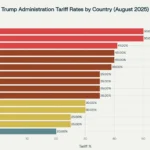The United States is experiencing a profound erosion of its global credibility across multiple dimensions, representing one of the most significant challenges to American leadership since World War II. This US credibility decline is documented through extensive data and manifests in six interconnected areas that collectively undermine America’s position as the world’s dominant superpower.
Military Overreach and Strategic Vulnerability
American military credibility faces unprecedented challenges as Pentagon war games consistently reveal alarming weaknesses against peer competitors. Multiple classified and unclassified simulations since 2018 show the United States struggling or outright failing to defend Taiwan against a Chinese invasion.
In these exercises, US forces are projected to exhaust critical munitions within 3-4 weeks of conflict, with some anti-ship missiles depleting in just days. The replacement timeline for these weapons stretches into years, not months.
Trump’s second-term military strategy has paradoxically worsened this situation through aggressive escalation. Since January 2025, the US has conducted 529 airstrikes across 240 sites in the Middle East, Central Asia, and Africa—nearly matching the 555 strikes executed during Biden’s entire four-year term.
| Trends | Data Points / Metrics | Description |
|---|---|---|
| US National Debt (2025) | Total debt ($36.93 trillion), % of GDP (124%), daily growth ($5.13 billion) | Shows fiscal strain underpinning credibility issues |
| US Military Capability | Number of airstrikes (529 in 2025), munitions depletion timelines, reliance on foreign supply chains | Highlights military overstretch and vulnerabilities |
| Dollar Dominance Trends | Decline in dollar value (11% H1 2025), drop in foreign Treasury holdings (30%), BRICS de-dollarization rates | Demonstrates the economic shift challenging US financial influence |
| Political Polarization Metrics | Trust in institutions (28%), approval ratings in NATO countries, partisan divisions | Reflects domestic dysfunction affecting foreign policy |
| Global Perception of US Leadership | Favorability ratings in 24 countries, tourism declines, alliance trust surveys | Captures the international reputation collapse and erosion of US soft power |
This “bomb first, ask questions later” approach has resulted in 224 civilian casualties in 2025 alone, nearly equaling the 258 civilian deaths from US actions over the previous 23 years. The strikes on Iranian nuclear facilities have drawn the US into a dangerous spiral of retaliation, forcing massive military deployments to the region when resources are already stretched thin.
The US military industrial base cannot support sustained conflict with China. American defense manufacturing has been severely compromised by decades of outsourcing critical components to potential adversaries.
The F-35 fighter program relies on Chinese-manufactured magnets, while China dominates machine tools, rare earth metals, lithium, and titanium essential for weapons production. Meanwhile, most US military explosives are produced at a single aging facility in Tennessee.
Economic Foundations Under Severe Strain
America’s fiscal position has deteriorated dramatically, undermining the economic foundation of its global influence. The national debt has reached an unprecedented $36.93 trillion as of August 2025, growing at an alarming rate of $5.13 billion per day. This represents 124% of GDP, with debt service consuming 14% of total federal spending. The Congressional Budget Office projects debt will exceed $52 trillion by 2035.
The most concerning development is that net interest payments as a share of federal outlays are forecast to reach 13.55% in fiscal 2025, climbing to 14.11% by fiscal 2027. This creates a vicious cycle where increasing portions of government revenue service existing debt rather than funding critical capabilities or investments.
Foreign ownership of US Treasury securities—the foundation of dollar dominance—has declined precipitously from over 50% during the 2008 financial crisis to just 30% in early 2025. This exodus of foreign investment forces higher yields to attract domestic buyers, increasing borrowing costs and creating fiscal pressures that constrain US credibility decline globally.
Dollar Dominance in Historic Decline
The US dollar experienced its worst performance since 1973 in the first half of 2025, falling 11% against major trading partners. This decline represents the end of a structural bull cycle that began in 2010. Morgan Stanley Research expects another 10% decline through 2026, warning that “we’re likely at the intermission rather than the finale”.
The dollar’s reserve currency status—critical to American economic hegemony—faces systematic erosion. Central bank holdings of dollars have dropped to a two-decade low of just under 60%, while gold purchases by emerging market central banks have doubled to 9% of reserves over the past decade. The bid-to-cover ratio for Treasury auctions, while still above 2.0, has shown concerning volatility as foreign demand weakens.
BRICS nations have accelerated de-dollarization efforts, with 90% of intra-BRICS trade now settled in local currencies, up from 65% just two years ago. While BRICS share of global GDP has reached 40% in purchasing power parity terms compared to 28% for the G7, their portion of cross-border bank settlement claims has risen to 15%. China’s yuan, though still small in absolute terms, is growing rapidly as an alternative settlement currency.
Trump’s threats of 100% tariffs against BRICS nations for pursuing de-dollarization have only accelerated the trend, with Kremlin spokesperson Dmitry Peskov noting that “more and more countries are switching to the use of national currencies in their trade”.
Domestic Political Dysfunction and Institutional Collapse
American political polarization has reached levels that fundamentally compromise foreign policy effectiveness and international credibility. Trust in US institutions has declined to historic lows, with only 28% of Americans expressing confidence in major institutions—the fourth consecutive year below 30%. Among the nine institutions tracked since 1979, Democrats’ confidence has plummeted to a new low of 26%.
The 2025 Democracy Perception Index reveals that 77% of Americans self-identifying as politically moderate has dropped to a record low of 34%. This polarization directly undermines foreign policy coherence, as partisan divisions now determine support for international commitments, alliance relationships, and military interventions.
Congressional dysfunction has severely damaged America’s ability to maintain consistent international commitments. The protracted debates over Ukraine aid in 2023-2024 exemplified how domestic polarization translates into unreliable international partnerships.
European allies watched in dismay as critical military assistance became hostage to unrelated domestic political battles over border security.
The weaponization of foreign policy for domestic political gain—exemplified by Trump’s pressure on Ukraine’s Zelenskyy to investigate political opponents—has fundamentally altered how international partners view American reliability. Foreign leaders now assume that US commitments may be reversed based on electoral cycles rather than strategic considerations.
Alliance Relationships in Crisis
America’s traditional allies are losing faith in US reliability at an unprecedented pace. Majorities of adults in five major Western European NATO countries now view the alliance as no longer strong or reliable due to current US politics. This represents a fundamental shift in transatlantic relations, with European leaders privately questioning whether NATO can survive Trump’s second term.
Global approval ratings for American leadership have collapsed. A Pew Research Center survey across 24 countries found that US ratings declined in 15 nations since spring 2024, including drops of 20 percentage points or more in Mexico, Sweden, Poland, and Canada.
In Canada—America’s closest neighbor—positive perceptions plummeted from 52% to just 19%, the largest recorded decline for any country since tracking began in 2015.
The US credibility decline is most pronounced among traditional allies. In France, 73% of the population no longer considers the United States an ally. Danish polling shows nearly half the population considers the US a serious threat to their country, surpassing concerns about Iran or North Korea. Across Europe, 56% of Canadians have canceled or altered planned trips to the US due to political concerns.
European nations are now actively planning for American withdrawal from NATO, with the UK, France, Germany, and Nordic countries formulating strategies to assume greater responsibility for continental defense over the next 5-10 years. This represents the most fundamental challenge to the transatlantic alliance since its founding in 1949.
Global Reputation in Freefall
International surveys document a catastrophic decline in America’s global standing. The 2025 Democracy Perception Index shows 55% of surveyed states now hold negative views of the United States, while China enjoys net favorable perceptions in 76 out of 96 countries. This represents a complete reversal from 2024, when the US enjoyed a net favorability of +20 compared to China’s +5.
Trump maintains negative perceptions in 82% of countries surveyed, significantly worse than both Vladimir Putin (61%) and Xi Jinping (44%). America’s net global perception rating has fallen from +22% in 2024 to -5% in 2025, placing it barely above Russia’s -9% and well below China’s +14%.
The Global Soft Power Index 2025 shows the US retaining its top ranking through structural advantages in familiarity and influence, but falling four positions to 15th globally in reputation. This indicates that while America maintains recognition and reach, its moral authority and attractiveness are eroding rapidly.
International tourism to the United States has declined 12-33% in the first quarter of 2025, with European travel dropping 30%. Land crossings from Canada fell 23% in March alone, jeopardizing 14,000 American jobs in the tourism industry.
The Compounding Crisis of US credibility decline
The erosion of American credibility represents more than isolated policy failures—it reflects the compounding effect of military overstretch, fiscal irresponsibility, monetary decline, political dysfunction, alliance deterioration, and reputational collapse. Each element reinforces the others, creating a downward spiral that threatens the foundations of American global leadership.
Most concerning is the acceleration of these trends under current leadership, with allies actively planning for American withdrawal from international commitments and adversaries exploiting American weaknesses to advance their own strategic objectives. The window for reversing these trends through traditional policy adjustments appears to be closing, as structural changes in the global balance of power may have already passed critical tipping points.















